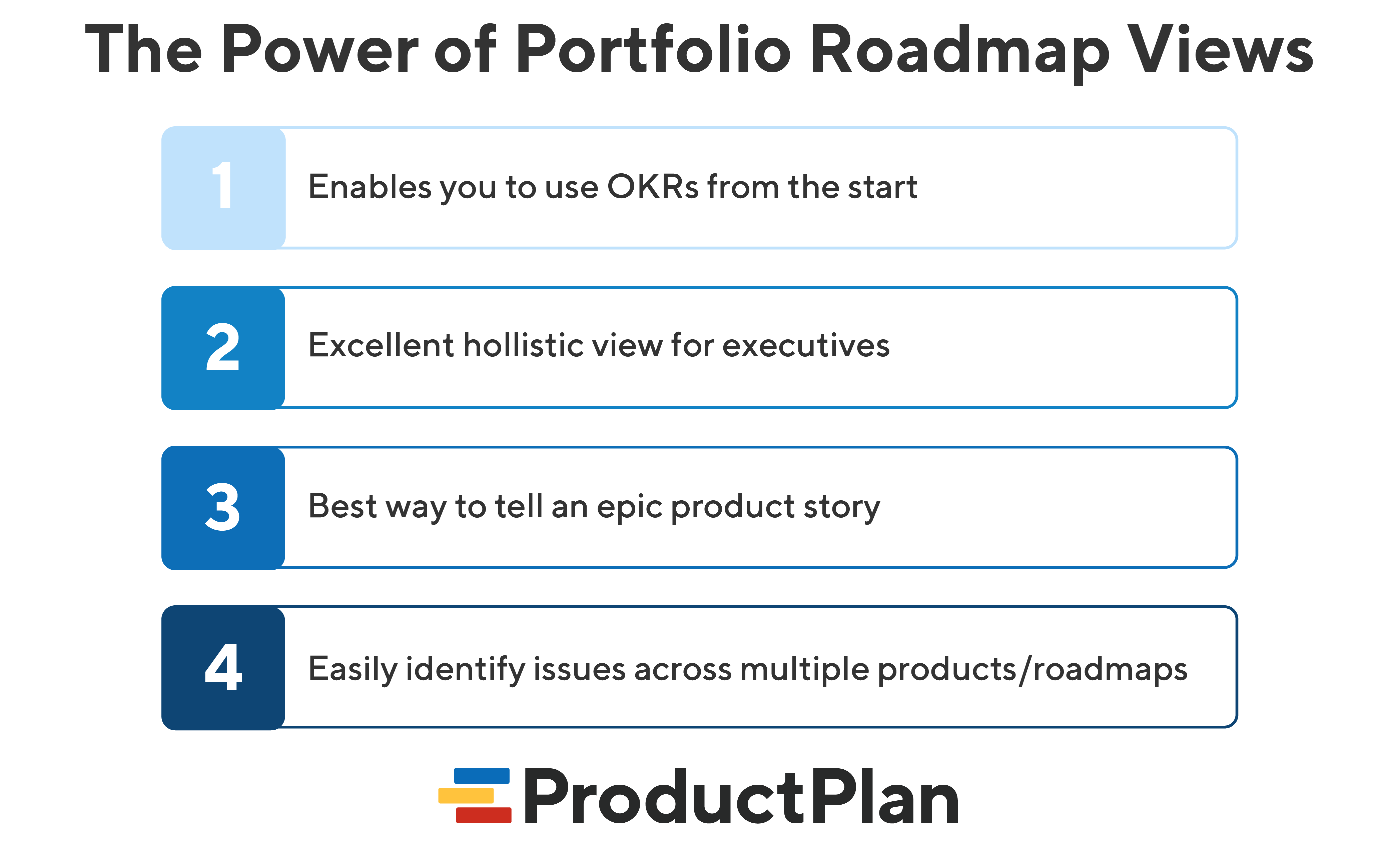No man—or product—is an island. Everything exists within a larger context and must fit into a bigger picture. But when it comes to product roadmaps, they’re often created with a more myopic view, but portfolio roadmap views can solve this.
There are good reasons for roadmaps to be viewed individually. Product roadmaps serve many purposes. They capture and organize information, communicate desired outcomes, and serve as an accessible communication point for a broad audience.
To keep things legible and clear, product managers must continually edit their product strategy. Their vision for that product’s future cannot drown in a sea of dates and details. Additionally, they must include a certain specificity level to ensure the implementation team knows what to build.
The Power of Portfolio Roadmap Views
But for director-level and above product leaders, their world is more significant than a single product. They’re managing entire product portfolios. Thus they deal with many products while dealing with numerous teams involved in each’s planning and execution.
Product managers require a view that supports a holistic picture while still retaining each specific product’s required details. This is where they use a portfolio roadmap view. These show the individual roadmaps of each product in the family. They are all in one place, and you can “zoom” in and out as needed.
This level of visibility has four critical benefits for the product leaders stakeholders alike.

1. Use OKRs from the start
While product leaders still sweat the details, what matters are results. The purpose of creating and iterating on these products comes from the top down. This could come from a single North Star metric driving every organization’s decision or a set of strategic goals shared across the company.
But once individual product teams get into the details of their particular product, it’s easy to lose sight of what’s most important. Customers complain stakeholders promote pet projects, and priorities get muddled.
By setting and continually returning to objectives and key results (OKRs), organizations keep their eyes on the prize. These metrics provide clear targets and predefined measures of success. Yet in organizations with multiple products, not every product targets or influences the same OKRs. It’s the combined, total portfolio that makes it all possible, a dedicated group effort.
When reviewing roadmaps in a side-by-side view, it’s easier to see how they’re working in aggregate. This view also supports resource allocation, so products receive an appropriate level of effort. Use color-coding, swimlanes, and legends to denote which individual product themes and initiatives are tied to each OKR make this particularly clear to the audience.
2. Excellent for executives
In larger organizations, the higher-ups should not be spending much time delving into the details of the product’s roadmap items. They generally don’t have the bandwidth or subject matter expertise to add value.
Far more important from the senior management perspective is seeing how the entire portfolio forges ahead. They want to see the movement toward the strategic objectives and critical metrics the organization has prioritized. This is far easier to learn when looking at a high-level view of how each product fits the scheme.
By using a color-coded, visual product portfolio roadmap views, all kinds of details become clear. Disconnects between the products are more pronounced. Disproportionate emphasis on one theme or goal than the others jumps out. Resource allocation issues surface, and time crunches make themselves known.
This is where executives can contribute by making important decisions and judgment calls or adjust expectations with customers and board members.
3. Tell an epic story
An individual product’s roadmap tells a tale. It illustrates the prioritized goals and outcomes as well as a path to get there. These dedicated documents are inspirational. But they are also instructive to the implementation teams working on these products. They also support the sales and marketing departments’ knowledge of what’s on the horizon.
But seeing events from only one character’s perspective would make for a rather myopic and biased story. A single product’s story doesn’t show where the entire product line—or the whole company—is heading.
To captivate and educate the audience while capturing the full scope, you must depict how all the various plot points, characters, and intrigue intersects. For product lines, the portfolio roadmap view is the canvas for this legendary narrative.
The portfolio roadmap views show how various products complement each other. This could be via parallel themes, such as adding mobile functionality to multiple products. Or this could be products that, in aggregate, facilitate more complex user tasks and stories.
As the timeline progresses, these portfolio roadmap views demonstrate the carefully plotted, intersecting, and common ways they can all be used in tandem.
This overarching vision is invaluable for everyone, from the teams implementing specific items on individual products to the board members reviewing the corporate strategy to the strategic customers and partners making their plans based on what’s to come.
4. Identifying issues
When viewed in a vacuum, an individual product roadmap usually shows a solid handle of the product strategy. The timelines of deliverables line up, calling out key milestones and dependencies.
But in a larger organization, those products aren’t operating in isolation. There are many interdependencies, economies of scale, and infrastructure to consider. This includes shared resources, marketing plans, and customer rollouts.
Laying this all out in one master view provides a pivotal perspective on how these various product roadmaps align or poorly overlap. This awareness triggers more detailed investigations on how to better coordinate.
This could be as subtle as rearranging some priorities to sync up the timing across products. Or it could be as drastic as removing redundant product components to avoid duplicate implementation efforts of market and customer confusion. Regardless of their scope, these realizations and later modifications would be missed without looking at everything together.
Portfolio Roadmap View is Easier Than it Sounds
Creating a portfolio roadmap view may seem like a tedious, impossible task. Picture endless meetings, attachments being emailed around (creating version control nightmares,) and wasted time reformatting slide decks and spreadsheets to make everything line up only to see it dashed when one product makes a change in plans.
But these are merely symptoms of a more fundamental problem. The product team is not using a purpose-built product roadmapping tool to manage their various products. A tool like ProductPlan eliminates many of these challenges, and you can generate portfolio roadmap views in minutes.
Since all the product roadmaps are already in the same system using a consistent format, a consolidated view is a snap. Product leaders select which specific product roadmaps they want to include in the view and then simply choose display and formatting options.
This includes Timeline, Kanban, or List Layout-style portfolio roadmaps, as well as using legends, swim lanes, and color-coding to customize the experience. All the relevant information from each product just rolls up and is presented in a comprehensive high-level view.
From here, reviewers can drill down into the details of any significant roadmap items as needed. But the high-level vision of how everything lines up is the “killer app” for the portfolio roadmap. Everything in one place, always up to date and accurate, and shareable with stakeholders.
Portfolio roadmap views are the essential resource product leaders don’t even realize they’re missing. Put it all in the picture and use portfolio roadmaps to analyze, build consensus, and share your product team’s vision with the world.





